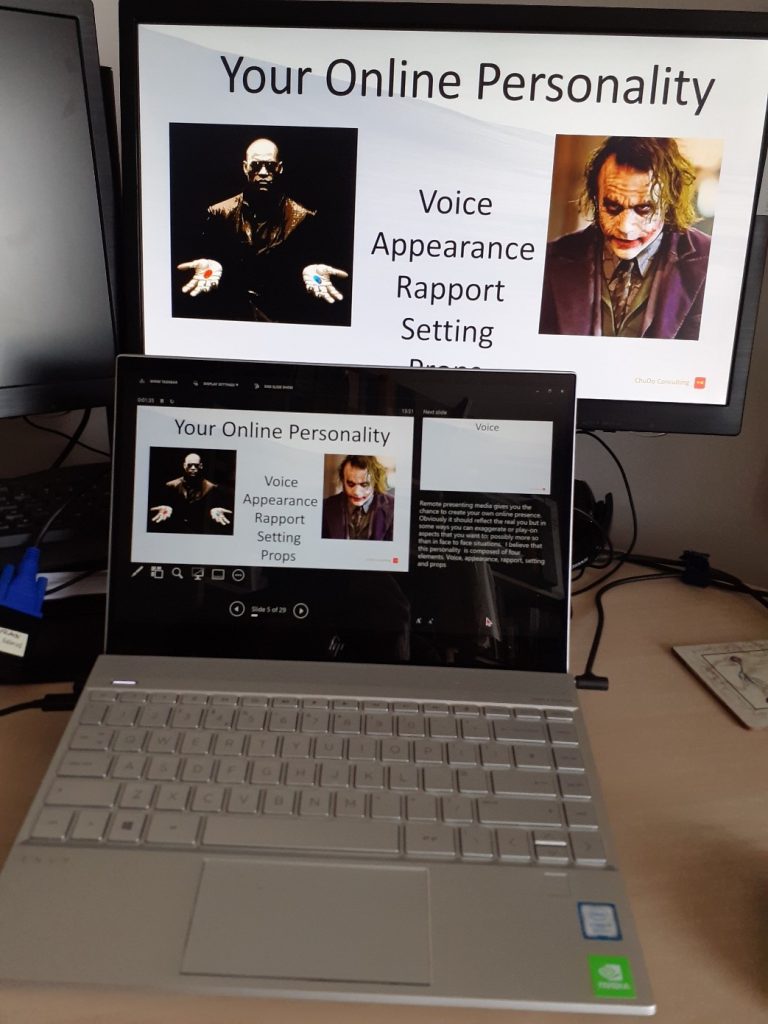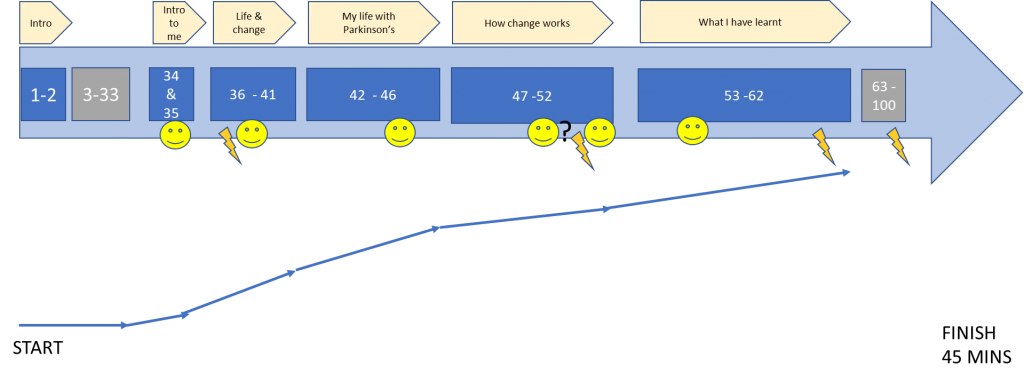The recent ‘Online Presentation Skills’ webinar presented by David Beckham was so well attended that it resulted in some unanswered questions due to time constraints. Here David gives his answers.

David Beckham, Principal Consultant, ChuDo Consulting
David will be speaking at the Virtual Business Analysis Conference Europe 21-23 September 2020 on the subject, ‘The Mythic BA’
To view the recording of the Online Presentations Skills Webinar please click here – at the end of the webinar there are more questions that were answered on the day.
Question: How do you recommend managing slides in presenter mode plus looking at the camera. Should you just use movie mode? What about written slide notes – would mean looking down at papers?
Dave’s answer: A large aspect of this is personal preference and I think you have to find a combination that works best for you as a speaker. I tend to set my laptop up as shown below, with screen share on the monitor and powerpoint presenter view on the laptop. This means even if I am looking at my monitor my gaze is vaguely in the direction of the camera and I don’t need written notes either, which is fine by me. It also keeps me mindful of the camera which can be a great help when doing your stuff!

Question: You’ve just mentioned animations in PowerPoint. What’s your view on this? Whole slide at once or reveal point-by-point? What about more sophisticated animations? (I’m not talking about things spinning in from the top of the screen or whatever – I mean more serious dynamic content)
Dave’s answer: I like PowerPoint animation provided it is employed in moderation and matches the tone of the material. In terms of basic animation on a slide I prefer bullet points appearing with a simple fade, triggered by a timing effect such as ‘start with click’ or ‘start with previous’. In general I avoid the more theatrical entrance effects such as bounce or spin etc.
I certainly am a fan of the more technically sophisticated animations as anyone who has seen one of my training sessions will probably appreciate. They can provide a useful break in rhythm or summarise a section but again they should be used in moderation and not as a substitute for your words.
Questions: Hello! Thanks for the session, David. Appreciate your sharing (top tip: don’t present on mute!). But, given that this year the conference is now pre-recorded, do you have any particular thoughts on that (Open question)? Record in chunks? Script? Lack of live interaction (no breakout rooms, polls, etc.) and Most of us are being asked to pre-record presentations – any specific tips there?
Dave’s answer: it will definitely be a different experience this year and in terms of pre-recording it’s a new world for me too! I will probably self-record and will probably do three run-throughs and pick the one I like the best. I think the trick will be keeping it as natural as possible, so I would avoid the temptation to simply stop if you make an error or use the wrong word. Just roll with it and see how it goes. I believe that people will prefer a more spontaneous feel rather than it sound too much like a recital. That’s why I tend to avoid scripts; admittedly they provide a sense of security and organisation but they provoke the ‘mistake’ reaction if you deviate from them. But again it’s down to personal perspective here and what works for you. Maybe it you can’t imagine presenting without a script you could do a crib-sheet or bullet point list.
The diagram below is part of my presentation skills workshop and shows how I’ve summarised my popular key note speech ‘The Power of Change’ onto a page where I can see the parts of the speech, where I get a laugh, ask a question or have a memorable moment. You might find it a useful template to do the same to your presentation if you intend to do it more than once.

Question: Any tips on how to stay focused on the camera? I am naturally drawn to look at faces and my slides?
Dave’s answer: Try to remember to keep returning to the webcam every so often. It is natural for our eyes to wander a bit whilst speaking so there’s no need to stare fixedly at the webcam but you need to remember that every time you look at it you are looking at everyone watching, which is useful but intimidating at the same time!
Question: Any thoughts on running a 3-hr workshop virtually?
Dave’s answer: My advice would be to construct the workshop in twenty minute blocks and then either have a Q&A, break-out or other change of rhythm. Make sure you have a proper comfort break after an hour or so as well. People will find it trying if you have sessions that are too long. Use plenty of visuals and vary your tone and rhythm. Don’t be afraid to be inventive either!
At the end of the webinar there is a 25 minute Question and Answer session where a lot of other questions were answered – To view the recording please click here
David Beckham has spent his career working in Financial Services, initially at Norwich Union then subsequently with Aviva. His career began in policy administration then moved into IT and he has been a Business Analyst in different guises since 1995. A founding member of the Business Analysis Practice he later had two terms as the Practice Lead. He worked on numerous large change programmes and was heavily involved in building the capability of Business Analysis within the organisation over the last decade. He has regularly presented at the European BA Conference and has had several articles published on Business Analysis topics. Despite being diagnosed with Parkinson’s Disease in 2010 at the age of 43 David continues to be a passionate advocate of the profession and the benefits it gives to organisations everywhere. Since 2015 David has regularly spoken on the positive power of change both on a professional and personal basis. David left Aviva in 2019 after 33 years to start his own consultancy.
David Beckham, Principal Consultant, ChuDo Consulting


